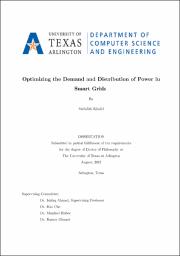
ATTENTION: The works hosted here are being migrated to a new repository that will consolidate resources, improve discoverability, and better show UTA's research impact on the global community. We will update authors as the migration progresses. Please see MavMatrix for more information.
Show simple item record
| dc.contributor.advisor | Ahmad, Ishfaq | |
| dc.creator | Khalid, Saifullah | |
| dc.date.accessioned | 2021-09-14T16:36:05Z | |
| dc.date.available | 2021-09-14T16:36:05Z | |
| dc.date.created | 2021-08 | |
| dc.date.issued | 2021-08-16 | |
| dc.date.submitted | August 2021 | |
| dc.identifier.uri | http://hdl.handle.net/10106/30028 | |
| dc.description.abstract | The electricity is generated in bulk power plants and transported to the end-user through the transmission and distribution networks. The process incurs heavy losses adding to the operational costs. Secondly, fossil fuels dominate energy generation and are a major source of greenhouse gases. Thirdly, the power grid is vulnerable to natural disasters. The smart grid addresses these challenges by integrating distributed energy resources (DERs) in the distribution system closer to the load and with greater penetration of renewable energy. Renewable energy is key to cutting carbon emissions due to fossil fuel-based electricity generation and reducing operating costs. It can also effectively help speedier localized service restoration before the main supply becomes available after a disaster. However, renewable energy sources, such as solar and wind, bring in a new challenge of intermittent generation which can destabilize the power grid. As a result, to incentivize the user to do demand-side management, the power grid employs dynamic electricity pricing.
In this context, this dissertation focuses on optimizing the demand and distribution of power in a smart grid. In the first case, we investigate profit maximization in geo-distributed data centers by optimizing power consumption through request routing and optimal resource allocation. Next, we extend this work by proposing a cooperative strategy where data centers incorporate grid stability into the optimization process. It enables the data centers to utilize lower power tariffs while minimizing geographic load balancing overheads. It also facilitates the grid to increase renewable penetration without catering to additional reserves. In the second case, this dissertation investigates the use of DERs to mitigate disaster effects through energy donation. Our approach simultaneously prioritizes critical load and provides relief to those in dire need while complying with resources and network constraints. Finally, this dissertation includes a blockchain approach to enable energy sharing for restoration in the aftermath of a disaster. The technique utilizes a consortium formulation mechanism and a lightweight consensus protocol for optimizing the blockchain operations' energy cost. The winner block selected through the proposed consensus mechanism intrinsically preserves network stability while conforming to resource and stability constraints.
We adopted evolutionary optimization techniques as a solution approach to address multi-objective problems and provide system managers with trade-off solutions to meet requirements posed by various operational scenarios. | |
| dc.format.mimetype | application/pdf | |
| dc.language.iso | en_US | |
| dc.subject | Smart grid | |
| dc.subject | Data center | |
| dc.subject | Service restoration | |
| dc.subject | Demand response | |
| dc.subject | Blockchain | |
| dc.subject | Energy sharing | |
| dc.subject | Consortium formulation | |
| dc.subject | Consensus protocol | |
| dc.subject | Request routing | |
| dc.subject | Resource allocation | |
| dc.subject | Geo-distributed data centers | |
| dc.subject | Cloud | |
| dc.subject | Dynamic pricing | |
| dc.subject | Energy donation | |
| dc.subject | Evolutionary algorithms | |
| dc.subject | Constraint handling | |
| dc.subject | Repair operator | |
| dc.title | OPTIMIZING THE DEMAND AND DISTRIBUTION OF POWER IN SMART GRIDS | |
| dc.type | Thesis | |
| dc.degree.department | Computer Science and Engineering | |
| dc.degree.name | Doctor of Philosophy in Computer Engineering | |
| dc.date.updated | 2021-09-14T16:36:05Z | |
| thesis.degree.department | Computer Science and Engineering | |
| thesis.degree.grantor | The University of Texas at Arlington | |
| thesis.degree.level | Doctoral | |
| thesis.degree.name | Doctor of Philosophy in Computer Engineering | |
| dc.type.material | text | |
| dc.creator.orcid | 0000-0002-3666-7398 | |
Files in this item
- Name:
- KHALID-DISSERTATION-2021.pdf
- Size:
- 2.998Mb
- Format:
- PDF
This item appears in the following Collection(s)
Show simple item record


